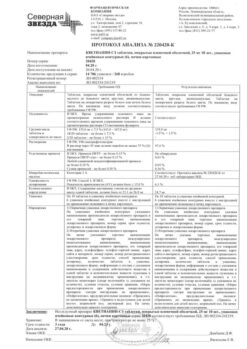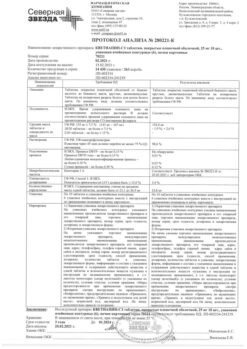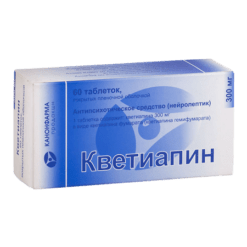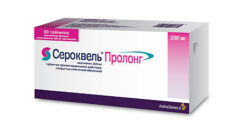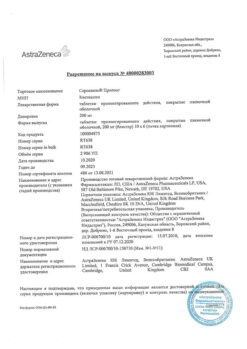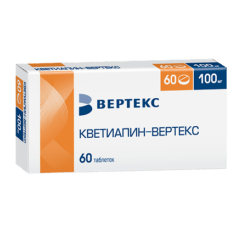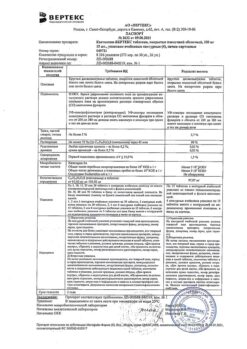No products in the cart.
Quetiapine, 25 mg 60 pcs
€1.00
Out of stock
(E-mail when Stock is available)
Description Pharmacotherapeutic group: Antipsychotic (neuroleptic) Pharmacokinetics:
ATX: N.05.A.H.04 Quetiapine
Pharmacodynamics:
Quetiapine is an atypical antipsychotic.
Quetiapine and its active metabolite N-dezalkylquetiapine (norquetiapine) interact with a wide range of brain neutrotransmitter receptors. Quetiapine and N-dezalkylquetiapine exhibit high affinity for 5HT2-serotonin receptors and brain D1 and D2 dopamine receptors. Antagonism to these receptors, combined with higher selectivity for 5NT2-serotonin receptors than for D2-dopamine receptors, accounts for the clinical antipsychotic properties with affinity for the 5NT1A-serotonin receptor, whereas N-dezalkylquetiapine exhibits high affinity for both. Inhibition of the noradrenaline transporter and partial agonism toward the 5NT1A-serotonin receptor by N-dezalkylquetiapine may account for the antidepressant effects. Quetiapine and N-desalkylquetiapine have high affinity to histamine and α1-adrenoreceptors and moderate affinity to α2-adrenoreceptors.
In addition, quetiapine has no or low affinity for muscarinic receptors, whereas N-dezalkylquetiapine exhibits moderate to high affinity for several muscarinic receptor subtypes with which anticholinergic (muscarinic-like) effects may be associated.
In standard tests, quetiapine exhibits antipsychotic activity. The specific contribution of the metabolite N-dezalkylquetiapine to the pharmacological activity of quetiapine has not been established. The results of a study of extrapyramidal symptoms (EPS) in animals revealed that quetiapine causes mild catalepsy at doses that effectively block D2 receptors. Quetiapine causes a selective decrease in the activity of mesolimbic A10-dopaminergic neurons compared to A9-nigrostriate neurons involved in motor function.
Efficacy
Quetiapine is effective for both positive and negative symptoms of schizophrenia. Quetiapine is effective as monotherapy for moderate to severe manic episodes.
There are no data on long-term use of quetiapine for the prevention of subsequent manic and depressive episodes.
The data on the use of quetiapine in combination with valproate seminatria or lithium preparations for moderate to severe manic episodes are limited, but this combination therapy was generally well tolerated.
In addition, quetiapine at doses of 300 mg and 600 mg is effective in patients with moderate to severe bipolar disorder types I and II. At the same time, the efficacy of quetiapine when taken at a dose of 300 mg and 600 mg per day is comparable.
Quetiapine is effective in patients with schizophrenia and mania when the drug is taken twice daily, despite the fact that the elimination half-life of quetiapine is about 7 hours. The effects of vetetiapine on 5NT2 and D2 receptors last up to 12 hours after taking the drug.
The incidence of EPS and concomitant use of m-cholinoblockers was comparable to that of placebo when quetiapine was administered with dose titration in schizophrenia. When quetiapine was administered in fixed doses of 75 to 750 mg/day to patients with schizophrenia, the incidence of EPS and the need for concomitant use of m-cholinoblockers did not increase.
When quetiapine was used in doses up to 800 mg/day to treat moderate to severe manic episodes, both as monotherapy and in combination with lithium or valproate semisodium, the incidence of EPS and concomitant use of m-cholinoblockers was comparable to that with placebo.
The pharmacokinetics of quetiapine are linear; no differences in pharmacokinetics were observed between men and women.
Intestation
In oral administration, quetiapine is well absorbed from the gastrointestinal tract. Food has no significant effect on the bioavailability of quetiapine.
Distribution
The binding to plasma proteins is approximately 83%. Peak molar concentrations in equilibrium of the active metabolite N-dezalkylquetiapine are 35% of those observed for quetiapine.
Metabolism
Quetiapine is actively metabolized in the liver. The CYP3A4 isoenzyme has been found to be the key CYP-mediated metabolism of quetiapine. The main plasma metabolites have no pronounced pharmacological activity. Quetiapine and some of its metabolites have weak inhibitory activity against CYP1A2, CYP2C9, CYP2C19, CYP2D6 and CYP3A4 isoenzymes, but only at concentrations 10-50 times higher than those observed at the usual effective dose of 300-450 mg/day.
Elimation
The elimination half-life of vetiapine and N-dezalkyl vetiapine is approximately 7 and 12 hours, respectively. Approximately 73% of vetiapine is excreted in the urine and 21% in the feces. Less than 5% of quetiapine is not metabolized and is excreted unchanged by the kidneys or in the feces.
Pharmacokinetics in special clinical cases
The average plasma clearance of quetiapine is approximately 25% lower in patients with severe renal impairment (CK< 30 mL/min/1.73 m2 ) and in patients with liver damage (compensated alcoholic cirrhosis), but individual clearance rates are within limits consistent with healthy subjects.
The average clearance of quetiapine in elderly patients is 30-50% lower than in patients aged 18 to 65 years.
In a study of healthy volunteers, concomitant use with ketoconazole resulted in a 235% and 522% increase in Cmax and AUC of quetiapine, respectively, with a corresponding 84% decrease in mean clearance when taken orally.
The half-life of vetiapine increased from 2.6 to 6.8 hours, but the mean maximum half-life (Tmax) remained unchanged.
.
Indications
Indications
– Treatment of acute and chronic psychoses, including schizophrenia.
– Treatment of manic episodes in the structure of bipolar disorder. Treatment of depressive episodes of moderate to severe severity in the structure of bipolar disorder.
– The drug is not indicated for the prevention of manic and depressive episodes.
Pharmacological effect
Pharmacological effect
Pharmacotherapeutic group: Antipsychotic (neuroleptic)
ATC: N.05.A.H.04 Quetiapine
Pharmacodynamics:
Quetiapine is an atypical antipsychotic drug.
Quetiapine and its active metabolite N-desalkylquetiapine (norquetiapine) interact with a wide range of neurotransmitter receptors in the brain. Quetiapine and N-desalkylquetiapine exhibit high affinity for 5HT2-serotonin receptors and D1 and D2 dopamine receptors in the brain. Antagonism to these receptors, combined with higher selectivity for 5HT2-serotonin receptors than for D2-dopamine receptors, determines the clinical antipsychotic properties by affinity for the 5HT1A-serotonin receptor, while N-dealkylquetiapine exhibits high affinity for both. Inhibition of the norepinephrine transporter and partial agonism at 5HT1A serotonin receptors exhibited by N-desalkylquetiapine may contribute to its antidepressant effect. Quetiapine and N-desalkylquetiapine have high affinity for histamine and α1-adrenergic receptors and moderate affinity for α2-adrenergic receptors.
In addition, quetiapine has no or low affinity for muscarinic receptors, while N-desalkylquetiapine exhibits moderate to high affinity for several muscarinic receptor subtypes, which may be associated with anticholinergic (muscarinic-like) effects.
In standard tests, quetiapine exhibits antipsychotic activity. The specific contribution of the N-desalkylquetiapine metabolite to the pharmacological activity of quetiapine has not been established. Results from studies of extrapyramidal symptoms (EPS) in animals revealed that quetiapine causes mild catalepsy at doses that effectively block D2 receptors. Quetiapine causes a selective decrease in the activity of mesolimbic A10-dopaminergic neurons compared to A9-nigrostriatal neurons involved in motor function.
Efficiency
Quetiapine is effective against both positive and negative symptoms of schizophrenia. Quetiapine is effective as monotherapy for moderate to severe manic episodes.
There are no data on long-term use of quetiapine for the prevention of subsequent manic and depressive episodes.
Data on the use of quetiapine in combination with semisodium valproate or lithium for moderate to severe manic episodes are limited, but this combination therapy was generally well tolerated.
In addition, quetiapine at doses of 300 mg and 600 mg is effective in patients with moderate to severe bipolar disorder I and II. At the same time, the effectiveness of quetiapine when taken at a dose of 300 mg and 600 mg per day is comparable.
Quetiapine is effective in patients with schizophrenia and mania when taken twice daily, although the half-life of quetiapine is approximately 7 hours. The effect of quetiapine on 5HT2 and D2 receptors lasts up to 12 hours after taking the drug.
When taking quetiapine with dose titration in schizophrenia, the frequency of EPS and concomitant use of m-anticholinergics was comparable to that when taking placebo. When quetiapine was prescribed in fixed doses from 75 to 750 mg/day to patients with schizophrenia, the incidence of EPS and the need for concomitant use of m-anticholinergic drugs did not increase.
When quetiapine was used in doses up to 800 mg/day for the treatment of moderate to severe manic episodes, either as monotherapy or in combination with lithium or semisodium valproate, the incidence of EPS and concomitant use of m-anticholinergic drugs was comparable to that with placebo.
Pharmacokinetics:
The pharmacokinetics of quetiapine is linear; there are no differences in pharmacokinetic parameters between men and women.
Suction
When taken orally, quetiapine is well absorbed from the gastrointestinal tract. Food does not significantly affect the bioavailability of quetiapine.
Distribution
Plasma protein binding is approximately 83%. Peak molar concentrations at steady state of the active metabolite N-desalkylquetiapine are 35% of those observed for quetiapine.
Metabolism
Quetiapine is actively metabolized in the liver. It has been established that the CYP3A4 isoenzyme is a key isoenzyme in the CYP-mediated metabolism of quetiapine. The main metabolites found in plasma do not have pronounced pharmacological activity. Quetiapine and some of its metabolites have weak inhibitory activity against the isoenzymes CYP1A2, CYP2C9, CYP2C19, CYP2D6 and CYP3A4, but only at concentrations 10-50 times higher than those observed at the usual effective dose of 300-450 mg / day.
Removal
The half-life of quetiapine and N-desalkylquetiapine is approximately 7 and 12 hours, respectively. Approximately 73% of quetiapine is excreted in urine and 21% in feces. Less than 5% of quetiapine is not metabolized and is excreted unchanged by the kidneys or feces.
Pharmacokinetics in special clinical situations
The average plasma clearance of quetiapine is approximately 25% less in patients with severe renal failure (creatinine clearance < 30 ml/min/1.73 m2) and in patients with liver damage (compensated alcoholic cirrhosis), but individual clearance rates are within the range corresponding to healthy people.
The average clearance of quetiapine in elderly patients is 30-50% less than in patients aged 18 to 65 years.
In a study of healthy volunteers, coadministration with ketoconazole resulted in an increase in quetiapine Cmax and AUC of 235% and 522%, respectively, with a corresponding reduction in mean oral clearance of 84%.
The half-life of quetiapine increased from 2.6 to 6.8 hours, but the mean maximum half-life (Tmax) remained unchanged.
Special instructions
Special instructions
Children and adolescents (ages 10 to 17 years)
Quetiapine is not indicated for use in children and adolescents under 18 years of age due to insufficient data on use in this age group. According to the results of clinical studies of quetiapine, some side effects (increased appetite, increased serum prolactin concentrations, vomiting, runny nose and fainting) were observed with a higher frequency in children and adolescents than in adult patients. Some adverse events (AEs) may have different consequences in children and adolescents compared to adult patients. An increase in blood pressure was also noted, which was not observed in adult patients. Changes in thyroid function have also been observed in children and adolescents. The effects on growth, puberty, mental development and behavioral reactions with long-term use (more than 26 weeks) of quetiapine have not been studied.
In placebo-controlled studies in children and adolescents with schizophrenia and mania in bipolar disorder, the incidence of advanced EPS was higher with quetiapine compared with placebo.
Suicide/suicidal ideation or clinical worsening
Depression in bipolar disorder is associated with an increased risk of suicidal ideation, self-harm, and suicide (suicide-related events). This risk persists until significant remission occurs. Because it may take several weeks or more for the patient’s condition to improve from the start of treatment, patients should be under close medical supervision until improvement occurs.
According to generally accepted clinical experience, the risk of suicide may increase in the early stages of remission. Patients (especially those at increased risk for suicide) and their caregivers should be warned to monitor for clinical worsening, suicidal behavior or thoughts, unusual changes in behavior, and to seek immediate medical attention if these occur.
In clinical trials in depressed patients with bipolar disorder, the risk of suicide-related events was 3.0% (7/233) for quetiapine and 0% (0/120) for placebo in patients aged 18–24 years; 1.8% (19/1616) for quetiapine and 1.8% (11/622) for placebo in patients over 25 years of age.
Other mental disorders for which quetiapine is prescribed are also associated with an increased risk of suicide-related events. In addition, such conditions may be comorbid with a depressive episode. Thus, the precautions used when treating patients with a depressive episode should also be taken when treating patients with other mental disorders.
If quetiapine therapy is abruptly discontinued, the potential risk of suicide-related events should be taken into account.
Patients with a history of suicidal events, as well as patients who clearly express suicidal thoughts before starting therapy, are at increased risk of suicidal intent and suicide attempts and should be carefully monitored during treatment.
An FDA meta-analysis of placebo-controlled studies of antidepressants, summarizing data from approximately 4,400 children and adolescents and 7,700 adult patients with mental disorders, found an increased risk of suicidal behavior with antidepressants compared with placebo in children, adolescents, and adult patients under 25 years of age. This meta-analysis does not include studies that used quetiapine.
In short-term placebo-controlled studies across all indications and all age groups, the incidence of suicide events was 0.8% for both quetiapine (76/9327) and placebo (37/4845).
In these studies in patients with schizophrenia, the risk of suicide-related events was 1.4% (3/212) for quetiapine and 1.6% (1/62) for placebo in patients aged 18–24 years; 0.8% (13/1663) for quetiapine and 1.1% (5/463) for placebo in patients over 25 years of age; 1.4% (2/147) for quetiapine and 1.3% (1/75) for placebo in patients under 18 years of age.
In patients with manic bipolar disorder, the risk of suicide-related events was 0% (0/60) for quetiapine and 0% (0/58) for placebo in patients aged 18–24 years; 1.2% (6/496) for quetiapine and 1.2% (6/503) for placebo in patients over 25 years of age; 1.0% (2/192) for quetiapine and 0% (0/90) for placebo in patients under 18 years of age.
Drowsiness
Drowsiness and associated symptoms such as sedation may occur during quetiapine therapy. In clinical studies involving patients with depression as part of bipolar disorder, somnolence usually developed during the first three days of therapy. The severity of this side effect was generally minor or moderate. If severe sleepiness develops, patients with depression as part of bipolar disorder may require more frequent visits to the doctor for 2 weeks after the onset of sleepiness or until symptoms improve. In some cases, discontinuation of quetiapine therapy may be necessary.
Patients with cardiovascular diseases
Caution should be exercised when prescribing quetiapine to patients with cardiovascular and cerebrovascular disease, and other conditions predisposing to hypotension.
Orthostatic hypotension may occur during quetiapine therapy, especially during dose titration at the beginning of therapy. Orthostatic hypotension and associated dizziness may increase the risk of accidental injury (fall), especially in older patients.
Patients should use caution until they adjust to these potential side effects. If orthostatic hypotension occurs, dose reduction or slower titration may be necessary.
Sleep apnea syndrome
Sleep apnea syndrome has been reported in patients taking quetiapine. Caution should be exercised when prescribing quetiapine to patients receiving drugs that have a depressant effect on the central nervous system, as well as patients with risk factors for sleep apnea (for example, overweight/obesity, male gender) or with a history of sleep apnea.
Seizures
There were no differences in the incidence of seizures in patients, 3 However, as with therapy with other antipsychotic drugs, caution is recommended when treating patients with a history of seizures with quetiapine.
Extrapyramidal symptoms
There was an increase in the incidence of EPS in adult patients with depression in the structure of bipolar disorder when taking quetiapine for depressive episodes compared to placebo.
While taking quetiapine, akathisia may occur, which is characterized by an unpleasant feeling of motor restlessness and the need to move, and is manifested by the patient’s inability to sit or stand without moving. If such symptoms occur, the dose of quetiapine should not be increased.
Tardive dyskinesia
If symptoms of tardive dyskinesia develop, it is recommended to reduce the dose of the drug or gradually discontinue it. Symptoms of tardive dyskinesia may worsen or even occur after you stop taking the drug.
Neuroleptic malignant syndrome
While taking antipsychotic drugs, including quetiapine, neuroleptic malignant syndrome may develop. Clinical manifestations of the syndrome include hyperthermia, altered mental status, muscle rigidity, lability of the autonomic nervous system, and increased creatine phosphokinase activity. In such cases, it is necessary to discontinue quetiapine and carry out appropriate treatment.
Severe neutropenia and agranulocytosis
In short-term, placebo-controlled clinical trials of quetiapine monotherapy, cases of severe neutropenia (neutrophil count <0.5 x 109/L) without infection were reported infrequently. The development of agranulocytosis (severe neutropenia associated with infections) has been reported in patients receiving quetiapine in clinical trials (rare), as well as during post-marketing use (including death). Most of these cases of severe neutropenia occurred several months after initiation of quetiapine therapy. No dose-dependent effect was found.
Active ingredient
Active ingredient
Quetiapine
Composition
Composition
One film-coated tablet, 25 mg, contains:
Active ingredient: quetiapine fumarate – 28.780 mg in terms of quetiapine – 25.000 mg.
Excipients (core): microcrystalline cellulose – 28,500 mg; lactose monohydrate – 19,000 mg; povidone type K-17 – 7,000 mg; sodium carboxymethyl starch (Primogel) – 7,000 mg; calcium hydrogen phosphate dihydrate – 8.720 mg; magnesium stearate – 1,000 mg.
Film shell: ready-made film coating system VTVACOAT® PA-3P-261 – 2.500 mg [hypromellose (HPMC) 6 / E464 – 0.975 mg, titanium dioxide / E171 – 0.746 mg, polydexgrosa / E 1200-0.375 mg, talc / E553b – 0.250 mg, macrogol 3350 – 0.150 mg, iron dye red oxide/E172 – 0.004 mg].
Pregnancy
Pregnancy
Pregnancy
The safety and effectiveness of quetiapine in pregnant women have not been established. Therefore, quetiapine can be used during pregnancy only if the expected benefit to the woman justifies the potential risk to the fetus.
When using antipsychotic drugs, including quetiapine, in the third trimester of pregnancy, newborns are at risk of developing adverse reactions of varying severity and duration, including EPS and/or withdrawal syndrome. Agitation, hypertension, hypotension, tremor, somnolence, respiratory distress, or feeding disturbances have been reported. In this regard, the condition of newborns should be carefully monitored.
Breastfeeding period
Reports of the excretion of quetiapine into breast milk have been published, but the extent of excretion has not been established. Women should be advised to avoid breastfeeding while taking quetiapine.
Contraindications
Contraindications
– Hypersensitivity to any component of the drug.
– Concomitant use with cytochrome P450 inhibitors, such as azole antifungals, erythromycin, clarithromycin and nefazodone, as well as HIV protease inhibitors.
– Children under 18 years of age (efficacy and safety have not been established).
– Lactose intolerance, lactase deficiency, glucose-galactose malabsorption.
With caution:
In patients with cardiovascular and cerebrovascular diseases or other conditions predisposing to arterial hypotension, advanced age, liver failure, a history of seizures, the risk of stroke and aspiration pneumonia.
Side Effects
Side Effects
The most common side effects of quetiapine (>10%) are drowsiness, dizziness, dry mouth, withdrawal syndrome, increased triglyceride concentrations, increased total cholesterol concentrations (mainly low-density lipoprotein cholesterol – LDL), decreased high-density lipoprotein cholesterol (HDL) concentrations, weight gain, decreased hemoglobin concentrations and extrapyramidal symptoms.
Very common (>1/10)
From the central nervous system:
Dizziness1,4,17, drowsiness2,17, headache, extrapyramidal symptoms1,13
From the gastrointestinal tract:
Dry mouth
Common disorders:
Withdrawal syndrome 1.10
Changes in laboratory and instrumental indicators:
Increased concentrations of triglycerides1,11, total cholesterol (mainly LDL cholesterol)1,12, decreased concentrations of HDL cholesterol1,18, increased body weight9, decreased hemoglobin concentration23
Often (>1/100, <1/10)
From the hematopoietic system:
Leukopenia1.25
From the central nervous system:
Dysarthria, unusual and nightmare dreams, increased appetite
From the cardiovascular system:
Tachycardia1,4, palpitations19, orthostatic hypotension1,4,17
From the side of the organ of vision:
Blurred vision
From the respiratory system:
Shortness of breath19
From the gastrointestinal tract:
Constipation, dyspepsia, vomiting21
Common disorders:
Mild asthenia, irritability, peripheral edema, fever
Changes in laboratory and instrumental parameters:
Increased ALT3 activity, increased GGT3 activity, decreased number of neutrophils1,22, increased number of eosinophils24, hyperglycemia1,7, increased concentration of prolactin in the blood serum16, decreased concentration of total and free T420, decreased
concentration of total T320, increased concentration of TSH20
Uncommon (>1/1000, <1/100)
From the cardiovascular system:
Bradycardia26
From the immune system:
Hypersensitivity reaction
From the central nervous system:
Cramps1, restless legs syndrome,
tardive dyskinesia1, fainting1,4,17
From the respiratory system:
Rhinitis
From the gastrointestinal tract:
Dysphagia1.8
From the kidneys and urinary tract:
Urinary retention
Changes in laboratory and instrumental parameters:
Increased activity of ACT3, thrombocytopenia4, prolongation of the QT interval1,13, decreased concentration of free T320
Rarely (>1/10000, <1/1000)
From the liver and biliary tract:
Jaundice6
From the reproductive system:
Priapism, galactorrhea
Common disorders:
Neuroleptic malignant syndrome1, hypothermia
Changes in laboratory and instrumental parameters:
Increased activity of creatine phosphokinase15, agranulocytosis27
From the central nervous system:
Somnambulism and similar phenomena
From the gastrointestinal tract:
Intestinal obstruction/ileus
Very rare (< 1/10000)
From the immune system:
Anaphylactic reactions6
Metabolic disorders:
Diabetes mellitus1,5,6
From the liver and biliary tract:
Hepatitis (with or without jaundice)6
For the skin and subcutaneous tissues:
Angioedema6, Stevens-Johnson syndrome6
Unspecified frequency
From the side of hematopoiesis:
Neutropenia1
Common disorders:
Withdrawal syndrome in newborns
1. See section “Special instructions”
2. Somnolence usually occurs within the first 2 weeks after initiation of therapy and usually resolves with continued use of quetiapine.
3. There may be asymptomatic increases (>3 times the upper limit of normal when measured at any time) in serum aspartate aminotransferase (AST), alanine aminotransferase (ALT) and gamma-glutamyl transpeptidase (GGT) activity, usually reversible with continued use of quetiapine.
4. Like other antipsychotic drugs with α1-blocking action, quetiapine often causes orthostatic hypotension, which is accompanied by dizziness, tachycardia, and in some cases fainting, especially at the beginning of therapy.
5. Very rare cases of decompensation of diabetes mellitus have been reported.
6. The frequency of this side effect was assessed based on the results of post-marketing surveillance.
7. Increased fasting blood glucose > 126 mg/dL (> 7.0 mmol/L) or postprandial blood glucose > 200 mg/dL (> 11.1 mmol/L) at least once.
8. A higher incidence of dysphagia with quetiapine compared with placebo was noted only in patients with depression in the structure of bipolar disorder.
9. Increase in initial body weight by at least 7%. Mostly occurs early in therapy in adults
10. When studying the withdrawal syndrome in short-term placebo-controlled clinical trials of quetiapine monotherapy, the following symptoms were noted: insomnia, nausea, headache, diarrhea, vomiting, dizziness and irritability. The incidence of withdrawal symptoms decreased significantly 1 week after stopping the drug.
11. Increased triglyceride concentration > 200 mg/dL (> 2.258 mmol/L) in patients > 18 years old or > 150 mg/dL (> 1.694 mmol/L) in patients < 18 years old, at least once determined.
12. An increase in the concentration of total cholesterol > 240 mg/dL (> 6.2064 mmol/L) in patients > 18 years old or > 200 mg/dL (> 5.172 mmol/L) in patients < 18 years old, at least with a single determination.
13. See further in the text of the Instructions.
14. Decrease in platelet count < 100 x 109/l, at least with a single determination.
15. No connection with neuroleptic malignant syndrome. According to clinical studies.
16. Increased prolactin concentration in patients >18 years of age: >20 mcg/l (> 869.56 pmol/l) in men; >30 mcg/L (> 1304.34 pmol/L) in women.
17. May cause falls.
18. Reduction of HDL cholesterol concentration < 40 mg/dL (< 1.03 mmol/L) in men and < 50 mg/dL (< 1.29 mmol/L) in women.
19. These phenomena were often noted against the background of tachycardia, dizziness, orthostatic hypotension and/or concomitant pathology of the cardiovascular or respiratory system.
20. Based on potentially clinically significant deviations from normal baseline observed in all clinical studies. Changes in the concentration of total T4, free T4, total T3, free T3 up to values of 5 mIU/l when measured at any time.
21. Based on the increased incidence of vomiting in elderly patients (age > 65 years).
22. In short-term clinical trials of quetiapine monotherapy in patients with a pre-therapy neutrophil count >1.5 x 109 /L, cases of neutropenia (neutrophil count 0.5 but <1.0 x 109 /L were observed with a frequency of 0.2% in the quetiapine and placebo group. A decrease in neutrophil count <0.5 x 109 /L at least with a single determination was observed in 0.21% of patients in the quetiapine group versus 0% in the placebo group.
23. A decrease in hemoglobin concentration <13 g/dL in men and <12 g/dL in women, at least with a single determination, was observed in 11% of patients while taking quetiapine in all clinical studies, including long-term therapy. In short-term placebo-controlled studies, decreases in hemoglobin concentration <13 g/dL in men and <12 g/dL in women, at least once measured, were observed in 8.3% of patients in the quetiapine group compared with 6.2% in the placebo group.
24. Based on potentially clinically significant deviations from baseline normal levels noted in all clinical studies. Increased eosinophil count > 1 x 109/L when measured at any time.
25. Based on potentially clinically significant deviations from baseline normal levels noted in all clinical studies. Decrease in white blood cell count < 3 x 109/L when measured at any time.
26. May occur during or shortly after initiation of therapy and be accompanied by hypotension and/or syncope. The frequency is based on reports of bradycardia and associated adverse events in all clinical studies of quetiapine.
27. Based on an estimate of the incidence in patients participating in all clinical trials of quetiapine who experienced severe neutropenia (<0.5 x 109/L) in combination with infections.
28. See section “Pregnancy and breastfeeding.”
QT prolongation, ventricular arrhythmia, sudden death, cardiac arrest, and torsade de pointes (TdP) are considered adverse effects of antipsychotic drugs. The incidence of EPS in short-term clinical studies in adult patients with schizophrenia and mania in bipolar disorder was comparable in the quetiapine and placebo groups (patients with schizophrenia: 7.8% in the quetiapine group and 8.0% in the placebo group; mania in bipolar disorder: 11.2% in the quetiapine group and 11.4% in the placebo group).
The incidence of EPS in short-term clinical studies in adult patients with depression in the structure of bipolar disorder in the quetiapine group was 8.9%, in the placebo group – 3.8%. At the same time, the frequency of individual symptoms of EPS (such as akathisia, extrapyramidal disorders, tremor, dyskinesia, dystonia, anxiety, involuntary muscle contractions, psychomotor agitation and muscle rigidity) was usually low and did not exceed 4% in each of the therapeutic groups. In long-term clinical trials of quetiapine for schizophrenia and bipolar disorder in adult patients, the incidence of EPS was comparable in the quetiapine and placebo groups.
During quetiapine therapy, a dose-dependent decrease in the concentration of thyroid hormones may be observed. The incidence of potentially clinically significant changes in thyroid hormone concentrations in short-term clinical studies for total T4 was 3.4% in the quetiapine group and 0.6% in the placebo group; for free T4 – 0.7% in the quetiapine group versus 0.1% in the placebo group; for total T3 – 0.54% in the quetiapine group versus 0.0% in the placebo group; for free T3 – 0.2% in the quetiapine group versus 0.0% in the placebo group.
Changes in TSH concentrations were observed with a frequency of 3.2% in the quetiapine group and 2.7% in the placebo group. In short-term monotherapy clinical trials, the incidence of potentially clinically significant changes in T3 and TSH concentrations was 0.0% in the quetiapine and placebo groups; for T4 and TSH was 0.1% in the quetiapine group versus 0.0% in the placebo group. These changes are usually not associated with clinically significant hypothyroidism. The maximum decrease in total and free T4 was recorded at the 6th week of quetiapine therapy, without further decrease in hormone concentrations during long-term treatment. In almost all cases, the concentration of total and free T4 returned to baseline levels after discontinuation of quetiapine therapy, regardless of the duration of treatment. The concentration of thyroxine-binding globulin (TBG) when measured in 8 patients remained unchanged.
Interaction
Interaction
Caution should be exercised when combining quetiapine with other drugs that affect the central nervous system, as well as with alcohol.
Caution should be exercised when quetiapine is used concomitantly with other drugs that have anticholinergic (muscarinic-like) effects.
The cytochrome P450 isoenzyme (CYP) 3A4 is the main isoenzyme responsible for the metabolism of quetiapine, which occurs through the cytochrome P450 system. In healthy volunteers, co-administration of quetiapine (at a dose of 25 mg) with ketoconazole, an inhibitor of the CYP3A4 isoenzyme, led to an increase in the area under the concentration-time curve (AUC) of quetiapine by 5-8 times.
Therefore, the combined use of quetiapine and inhibitors of the CYP3A4 isoenzyme is contraindicated. It is also not recommended to use quetiapine with grapefruit juice.
In a pharmacokinetic study, repeated dosing of quetiapine before or concomitantly with carbamazepine resulted in a significant increase in quetiapine clearance and a corresponding decrease in AUC by an average of 13% compared to quetiapine administered without carbamazepine. In some patients, the decrease in AUC was even more pronounced. This interaction is accompanied by a decrease in quetiapine plasma concentrations and may reduce the effectiveness of quetiapine therapy.
The combined use of quetiapine with phenytoin, another inducer of microsomal liver enzymes, was accompanied by an even more pronounced (approximately 450%) increase in quetiapine clearance.
The use of quetiapine in patients receiving microsomal liver enzyme inducers is possible only if the expected benefit from quetiapine therapy outweighs the risk associated with discontinuation of the microsomal liver enzyme inducer drug. Changing the dose of drugs that induce microsomal liver enzymes should be gradual. If necessary, it is possible to replace them with drugs that do not induce microsomal liver enzymes (for example, valproic acid drugs).
The pharmacokinetics of quetiapine did not change significantly with simultaneous use of the antidepressant imipramine (inhibitor of the CYP2D6 isoenzyme) or fluoxetine (inhibitor of the CYP3A4 and CYP2D6 isoenzymes).
The pharmacokinetics of quetiapine does not change significantly when used concomitantly with the antipsychotic drugs risperidone or haloperidol. However, concomitant use of quetiapine and thioridazine resulted in an approximately 70% increase in quetiapine clearance.
The pharmacokinetics of quetiapine does not change significantly with simultaneous use of cimetidine.
With a single dose of 2 mg of lorazepam while taking quetiapine at a dose of 250 mg 2 times a day, the clearance of lorazepam is reduced by approximately 20%.
The pharmacokinetics of lithium preparations does not change with simultaneous use of quetiapine. There were no clinically significant changes in the pharmacokinetics of valproic acid and quetiapine with the combined use of semisodium valproate and quetiapine.
Pharmacokinetic studies examining the interaction of quetiapine with drugs used for cardiovascular diseases have not been conducted.
Caution should be exercised when using quetiapine in combination with drugs that can cause electrolyte imbalance and prolongation of the QTc interval.
Quetiapine did not induce liver microsomal enzymes involved in the metabolism of phenazone.
False-positive results of screening tests for methadone and tricyclic antidepressants using enzyme-linked immunosorbent assays have been reported in patients taking quetiapine. To confirm the screening results, a chromatographic study is recommended.
Overdose
Overdose
A death was reported with 13.6 g of quetiapine in a patient participating in a clinical trial, and a death was reported with 6 g of quetiapine in a post-marketing study. At the same time, a case of taking quetiapine in a dose exceeding 30 g without death has been described. There are reports of extremely rare cases of quetiapine overdose, leading to an increase in the QTc interval, death or coma.
In patients with a history of severe cardiovascular disease, the risk of side effects from overdose may increase.
Symptoms noted in overdose were mainly due to an increase in the known pharmacological effects of the drug, such as drowsiness and sedation, tachycardia, decreased blood pressure and anticholinergic effects.
Storage conditions
Storage conditions
In a place protected from light, at a temperature not exceeding 25 ° C.
Keep out of the reach of children.
Shelf life
Shelf life
3 years.
Do not use after the expiration date stated on the package.
Manufacturer
Manufacturer
Moscow Endocrine Plant, Russia
Additional information
| Shelf life | 3 years. Do not use after the expiration date printed on the package. |
|---|---|
| Conditions of storage | In the dark place at a temperature not exceeding 25 °С. Store out of the reach of children. |
| Manufacturer | Moscow Endocrine Plant, Russia |
| Medication form | pills |
| Brand | Moscow Endocrine Plant |
Other forms…
Related products
Buy Quetiapine, 25 mg 60 pcs with delivery to USA, UK, Europe and over 120 other countries.



